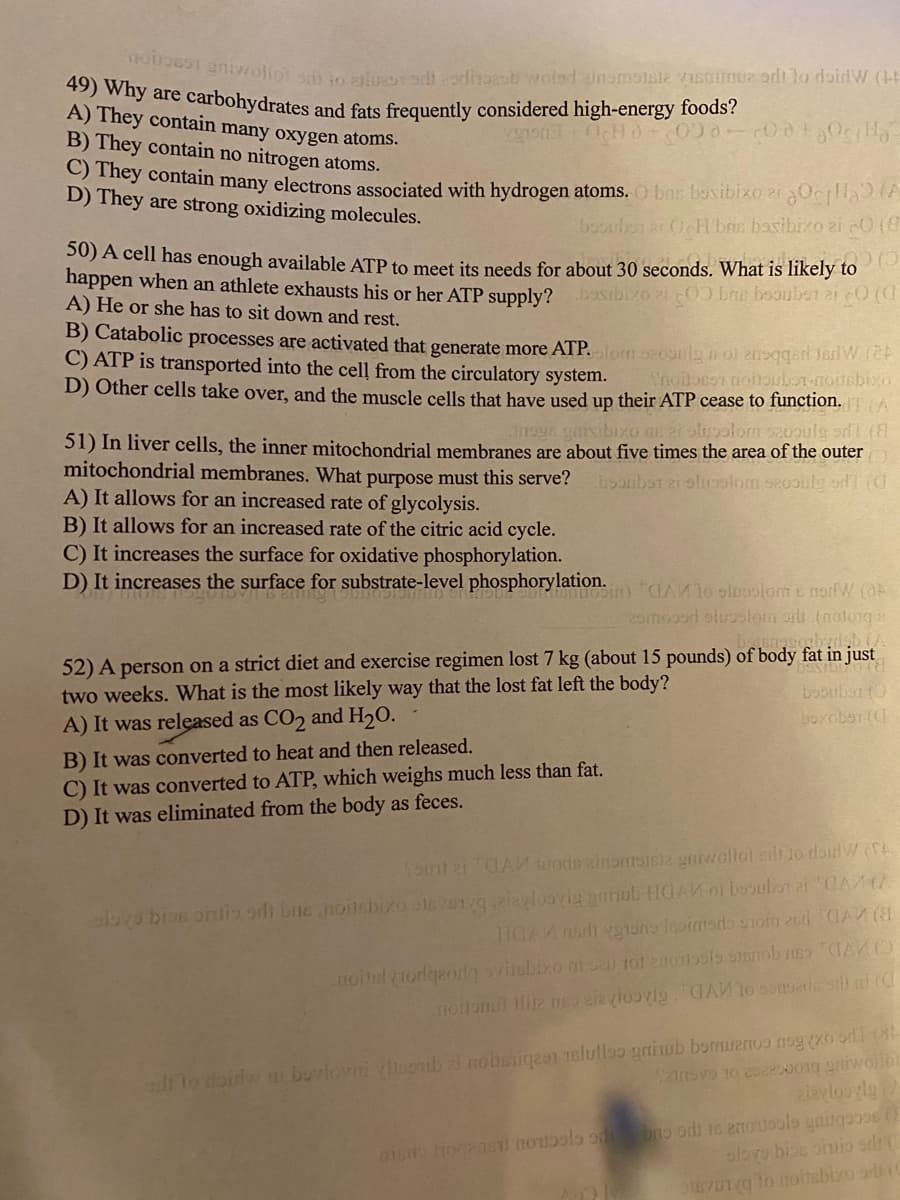49) Why are carbohydrates and fats frequently considered high-energy foods? A) They contain many oxygen atoms. B) They contain no nitrogen atoms. C) They contain many electrons associated with hydrogen atoms. Obns bosibiX r D) They are strong oxidizing molecules. booubon ar OcH bas basi
49) Why are carbohydrates and fats frequently considered high-energy foods? A) They contain many oxygen atoms. B) They contain no nitrogen atoms. C) They contain many electrons associated with hydrogen atoms. Obns bosibiX r D) They are strong oxidizing molecules. booubon ar OcH bas basi
Human Anatomy & Physiology (11th Edition)
11th Edition
ISBN:9780134580999
Author:Elaine N. Marieb, Katja N. Hoehn
Publisher:Elaine N. Marieb, Katja N. Hoehn
Chapter1: The Human Body: An Orientation
Section: Chapter Questions
Problem 1RQ: The correct sequence of levels forming the structural hierarchy is A. (a) organ, organ system,...
Related questions
Question
Need a clear explanation for the 4 question please

Transcribed Image Text:ny are carbohydrates and fats frequently considered high-energy foods?
A) They contain many oxygen atoms.
B) They contain no nitrogen atoms.
mey contain many electrons associated with hydrogen atoms. O bns bovibixo ei Ocla (A
D) They are strong oxidizing molecules.
boonbon ar OcH bas basibizo zi O (
50) A cell has enough available ATP to meet its needs for about 30 seconds. What is likely to
happen when an athlete exhausts his or her ATP supply?
A) He or she has to sit down and rest.
boxibizo 2i 0 bra boouber ai 0 (a
B) Catabolic processes are activated that generate more ATP.om 20ula nol ensqgeri Jer W.(e
C) ATP is transported into the cell from the circulatory system.
Snodonsr noioubor-nousbixo
D) Other cells take over, and the muscle cells that have used up their ATP cease to function. A
nsun paisibixo an 2t olgolom s20oulg sd (8
51) In liver cells, the inner mitochondrial membranes are about five times the area of the outer
mitochondrial membranes. What purpose must this serve?
A) It allows for an increased rate of glycolysis.
B) It allows for an increased rate of the citric acid cycle.
C) It increases the surface for oxidative phosphorylation.
D) It increases the surface for substrate-level phosphorylation. Ao oluosiome rorW (OF
boonbor zi sluolom seooule srd (a
29mod oluolom art (notoiq
52) A person on a strict diet and exercise regimen lost 7 kg (about 15 pounds) of body fat in just
boouban0
boxobor ((
two weeks. What is the most likely way that the lost fat left the body?
A) It was released as CO2 and H20.
B) It was converted to heat and then released.
C) It was converted to ATP, which weighs much less than fat.
D) It was eliminated from the body as feces.
fomt ziCAM luods inormsici gniwollol elt lo rloirW (A
abro bios onlio ad bnenoitebixo stvUvgziazloovig gonub HGAM oi bosuban ai CAM
noitel odqorlg visbixo ni oal tot 20015ois arenob s CIAO
d lo dai t bovlovni viloenib ei nobsiqeen 1elullao griub bormeoo nog xo T (
2iayloovlg
sovo bios oiio sdt (
vUTg lo noinsbixo ade
Expert Solution
This question has been solved!
Explore an expertly crafted, step-by-step solution for a thorough understanding of key concepts.
This is a popular solution!
Trending now
This is a popular solution!
Step by step
Solved in 2 steps

Knowledge Booster
Learn more about
Need a deep-dive on the concept behind this application? Look no further. Learn more about this topic, biology and related others by exploring similar questions and additional content below.Recommended textbooks for you

Human Anatomy & Physiology (11th Edition)
Biology
ISBN:
9780134580999
Author:
Elaine N. Marieb, Katja N. Hoehn
Publisher:
PEARSON

Biology 2e
Biology
ISBN:
9781947172517
Author:
Matthew Douglas, Jung Choi, Mary Ann Clark
Publisher:
OpenStax

Anatomy & Physiology
Biology
ISBN:
9781259398629
Author:
McKinley, Michael P., O'loughlin, Valerie Dean, Bidle, Theresa Stouter
Publisher:
Mcgraw Hill Education,

Human Anatomy & Physiology (11th Edition)
Biology
ISBN:
9780134580999
Author:
Elaine N. Marieb, Katja N. Hoehn
Publisher:
PEARSON

Biology 2e
Biology
ISBN:
9781947172517
Author:
Matthew Douglas, Jung Choi, Mary Ann Clark
Publisher:
OpenStax

Anatomy & Physiology
Biology
ISBN:
9781259398629
Author:
McKinley, Michael P., O'loughlin, Valerie Dean, Bidle, Theresa Stouter
Publisher:
Mcgraw Hill Education,

Molecular Biology of the Cell (Sixth Edition)
Biology
ISBN:
9780815344322
Author:
Bruce Alberts, Alexander D. Johnson, Julian Lewis, David Morgan, Martin Raff, Keith Roberts, Peter Walter
Publisher:
W. W. Norton & Company

Laboratory Manual For Human Anatomy & Physiology
Biology
ISBN:
9781260159363
Author:
Martin, Terry R., Prentice-craver, Cynthia
Publisher:
McGraw-Hill Publishing Co.

Inquiry Into Life (16th Edition)
Biology
ISBN:
9781260231700
Author:
Sylvia S. Mader, Michael Windelspecht
Publisher:
McGraw Hill Education